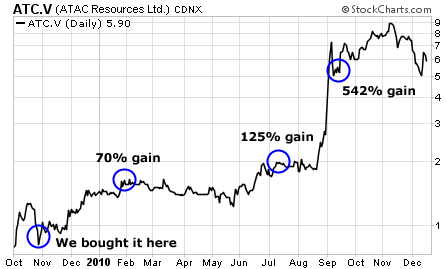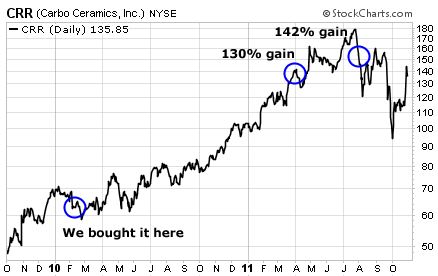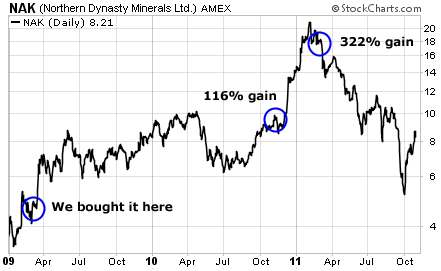 [Editor’s note: Below, you’ll find the third installment of our “how to” series on resource investing. We’ve shown you the “tools” of the trade… and how to handle the market’s booms and busts. Today, we’ll give you the best strategy for reducing risk and maximizing your gains.]
[Editor’s note: Below, you’ll find the third installment of our “how to” series on resource investing. We’ve shown you the “tools” of the trade… and how to handle the market’s booms and busts. Today, we’ll give you the best strategy for reducing risk and maximizing your gains.]
Not one man saw the bloodshed that was coming…
In the summer of 2008, I spent three weeks in Vancouver. The city is home to the thousands of junior resources companies that trade on Toronto’s Venture Exchange, the “Dow Jones of small resource stocks.”
[ad#Google Adsense 336×280-IA]While I was there, I spoke to dozens of industry insiders, geologists, and mining company execs. These are the sector “insiders.” Many of them make their living speculating in junior mining stocks…
But no one knew what was coming…
By December that year – six months later – the Venture Index had dropped nearly 75%.
Most resource stock owners were caught with their pants down. They didn’t have an exit strategy in place. They should have booked big gains and cut their losses early. Instead, they watched millions of dollars in profits evaporate… and rode their stocks all the way down.
Often, resource investors are their own worst enemies. They’ll sell winners too early to lock in fast gains… or they’ll hold on to a loser because of hope or the reluctance to admit they were wrong about a position.
But “hope” doesn’t qualify as a selling plan.
Fortunately, there’s a simple system you can use with your resource trades that will both reduce your risk and maximize your returns.
Let me show you how it works with an example…
Back in 2009, I recommended buying shares of a promising gold explorer, ATAC Resources. As I explained in yesterday’s essay, “juniors” like ATAC are the bloodhounds of the resource business. They are tiny companies that scour the world looking for the next big deposit. When one of them finds a huge deposit, shares absolutely skyrocket.
But that kind of potential doesn’t come without risk. So we had a “sell” strategy starting from the very first day we bought it.
In this case, I set a 50% trailing stop. In other words, we were prepared to lose half our investment before we sold. The huge potential reward made up for that level of risk.
The rewards came quickly. We made a 70% initial gain when the stock bounced up to $1.50 over the first three months. Many investors (particularly those without a plan) would have taken that cash off the table right then and there. They’d be ecstatic with a 70% gain in three months.
But I knew the 2010 drilling season hadn’t even begun. I knew that initial return was just other investors hearing the story and getting excited. The big potential was still coming. So I kept my 50% trailing stop in place (in case I was wrong) and sat back to watch.
By mid-July, we had a 125% gain. Again, there was that temptation to lock in gains… But I knew only half the drilling program was complete, less than one-quarter of the analysis on the drill cores was done. So we continued to hold.
By late August, drilling confirmed ATAC had discovered a major new gold deposit in the Yukon. The company’s shares suddenly grew wings and soared. They rocketed from $1.85 on August 19 to $7.22 on September 7.
As the stock rose, we tightened our trailing stop. That was our predetermined point at which would sell the stock if the uptrend stalled… or started to head lower.
A trailing stop is easy to figure. For example, if a stock’s highest closing price is $10 and you set a 25% trailing stop, you’d exit the stock if it declined below $7.50 (25% of $10 is $2.50, $10 minus $2.50 is $7.50).
Using a trailing stop is useful because no matter how smart you are… or how well you know the fundamentals behind a resource company… you never know just how much the market will fall in love with a stock. The market often pushes winning resource plays to levels well beyond reason.
By setting a trailing stop, you’re able to sit with your winner, instead of selling it too early and missing out on gains.
My colleague Steve Sjuggerud encourages folks to think of profit-taking situations like this: We got in early and picked a great seat in the middle of the movie theater. We’ve enjoyed a great show. But we think the show might be ending… and the crowd in the theater could head for the exits at any time. So we’re going to move to the seat next to the exit.
We’re not “leaving” just yet. We’re going tighten our trailing stops to preserve gains and ride the trend as long as it lasts… while staying ready to exit before a possible stampede.
So… during the incredible run we had with ATAC, we tightened our trailing stop to 25%… rode the stock a little longer… and then tightened the trailing stop again to 10%.
Ultimately, we were stopped out at $5.65 on September 8, 2010 for a 542% gain.

The secret to our success was simple. We had an exit plan, all the way.
We started with a wide stop, to account for the natural volatility in small resource stocks. As the gains came in and shares stretched higher, we tightened the stop to protect our profits. That allowed us to catch more upside without jeopardizing our gains.
In short, it allowed us to maximize our gains and minimize our risk. Let me show you another example…
Carbo Ceramics makes a special product called proppant.
Proppant is used in the hydraulic fracturing process to “prop” open the cracks made when the company forces water down the bore hole. Hydraulic fracturing (or “fracking”) is the technique that blew the doors off the U.S. oil and gas industry. Suddenly, we can get natural gas and oil from rocks that were considered dead just 15 years ago.
I knew this would be a huge trend… which is why we bought Carbo in February 2010. Carbo was operating at full blast. It was building new lines of production and raising its prices… The sky was the limit.
We bought the stock when shares were trading at $60.70. We initially placed a 25% trailing stop on our position. About a year later, we were up 130%, and it was time to tighten our stop to 15%.
At its top, the stock traded for $180 per share. We were up almost 200% on the trade. But then the stock turned down. The shares dropped as low as $94. But our tighter stop got us out at $154, for a 142% gain.
If we’d held on, we would have seen two-thirds of our profits evaporate. Take a look at a chart of the company’s performance over the period we owned the shares…

Again, the secret to success was our exit plan. We didn’t take profits early… and we didn’t hang on too late.
These aren’t isolated cases, either. Almost all of our biggest wins in the S&A Resource Report have played out exactly the same way. We never enter a position without an exit plan. And when a position takes off and heads hundreds of percent higher, we adjust our exit plan – we “tighten” our trailing stops to protect our gains.
Here’s one more example…
In early 2009, near the depths of the credit crisis, I recommended shares of Northern Dynasty Minerals. The company owns the rights to one of the world’s largest untapped gold and copper deposits. We placed a 50% stop loss on the position.
Back then, the market value of Northern Dynasty was $500 million. But I thought the company was worth between $1 billion and $1.5 billion in a good market. Turns out, I underestimated our profits by quite a bit…
Our shares had more than doubled by November 2010, so we tightened our trailing stop from 50% to 25% to help protect our gains. But the stock continued to rip higher on news of a possible takeover, and we tightened the stop loss again to lock in this huge gain.
We sold near the top, ultimately capturing a 322% gain… and sidestepping an eventual 70% drop.

In the S&A Resource Report, we’ve followed this model of taking profits in other resource firms like royalty company Silver Wheaton (+345%), Chinese gold miner Jinshan Gold (+339%), and several other triple-digit winners.
Stock like these can add booster rockets to your portfolio… but you must have a system for “ringing the cash register” and taking profits.
Have a plan to protect your initial capital when you buy, and have a plan to take profits. You’ll be a much more successful resource investor if you do.
Good investing,
Matt Badiali
P.S. Tomorrow, I’ll wrap up our “how-to guide” for commodity investors and show you the single most important factor in natural resource investment. With this one number in your favor, you could see decades of outsized gains. Don’t miss it.
Sponsored Link: Matt Badiali is the editor of the S&A Resource Report. In the last year, Matt has closed 20 winning positions… five of which earned subscribers triple-digit gains. To access this service – and learn about one of the most bizarre resource ideas Matt has ever discovered – click here.
Source: The Growth Stock Wire
